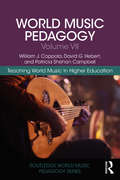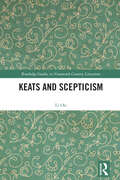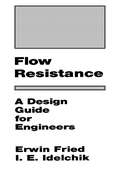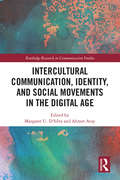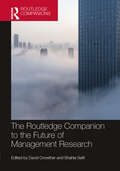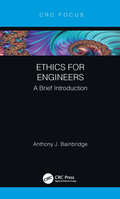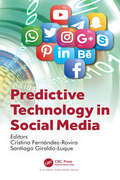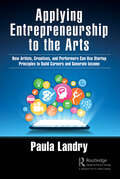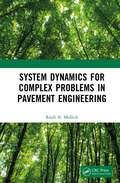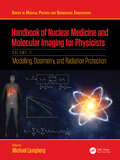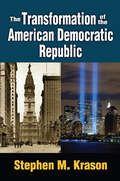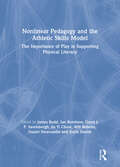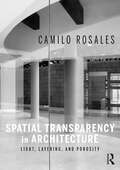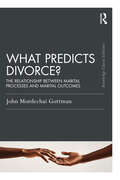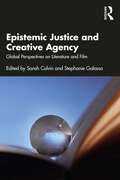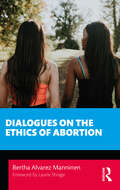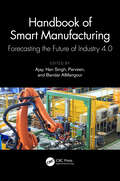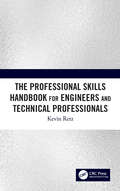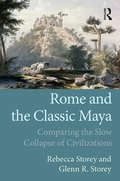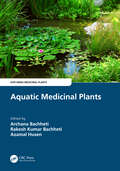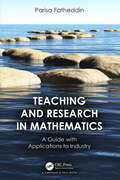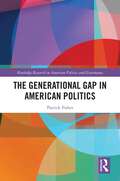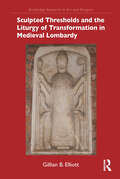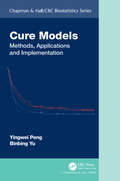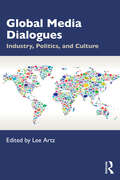- Table View
- List View
World Music Pedagogy, Volume VII: Teaching World Music in Higher Education (Routledge World Music Pedagogy Series)
by William J. Coppola David G. Hebert Patricia Shehan CampbellWorld Music Pedagogy, Volume VII: Teaching World Music in Higher Education addresses a pedagogical pathway of varied strategies for teaching world music in higher education, offering concrete means for diversifying undergraduate studies through world music culture courses. While the first six volumes in this series have detailed theoretical and applied principles of World Music Pedagogy within K-12 public schools and broader communities, this seventh volume is chiefly concerned with infusing culture-rich musical experiences through world music courses at the tertiary level, presenting a compelling argument for the growing need for such perspectives and approaches.These chapters include discussions of the logical trajectories of the framework into world music courses, through which the authors seek to challenge the status quo of lecture-only academic courses in some college and university music programs. Unique to this series, each of these chapters illustrates practical procedures for incorporating the WMP framework into sample classes. However, this volume (like the rest of the series) is not a prescriptive "recipe book" of lesson plans. Rather, it seeks to enrich the conversation surrounding cultural diversity in music through philosophically-rooted, social justice-conscious, and practice-oriented perspectives.
Keats and Scepticism (Routledge Studies in Nineteenth Century Literature)
by Li OuKeats and Scepticism explores Keats’s affinity with the philosophical tradition of scepticism and reads Keats’s poetry anew in the light of this affinity. It suggests Keats’s links with the origin of scepticism in ancient Greece as recorded in Sextus Empiricus’s Outlines of Scepticism. It also discusses Keats’s connections with Montaigne, the most important Renaissance inheritor of Pyrrhonian scepticism; Voltaire, the Enlightenment philosophe whose sceptical ideas made an indelible impact on Keats; and Hume, the most thoroughgoing sceptic after antiquity. Other than Keats’s affinitive ideas with these sceptical thinkers, this book is particularly interested in Keats’s experiments with the peculiar language, forms, modes, and genres of poetry to convey the non-dogmatic philosophy. In this light, it re-reads Isabella, ‘La Belle Dame sans Merci’, the 1819 odes, the two Hyperions, King Stephen, and Lamia, all of which reveal Keats’s self-reflexive and radical sceptical poetics in challenging poetic dogmas and conventions. This book is for Keats lovers, students, teachers, scholars, or non-academic readers who are interested in Romanticism, nineteenth-century studies, or poetry and philosophy in general. This original, accessible interdisciplinary study aims to offer the reader a fresh perspective to read Keats and appreciate the quintessential Keatsian poetics.
Flow Resistance: Design Guide For Engineers
by I.E. IdelchikA sourcebook offering an up-to-date perspective on a variety of topics and using practical, applications-oriented data necessary for the design and evaluation of internal fluid system pressure losses. It has been prepared for the practicing engineer who understands fluid-flow fundamentals.
Intercultural Communication, Identity, and Social Movements in the Digital Age (Routledge Research in Communication Studies)
by Margaret U. D’Silva; Ahmet AtayThis book examines the complex and multidimensional relationship between culture and social media, and its specific impact on issues of identity and social movements, in a globalized world. Contemporary cyber culture involves communication among people who are culturally, nationally, and linguistically similar or radically different. Social media becomes a space for mediated cultural information transfer which can either facilitate a vibrant public sphere or create cultural and social cleavages. Contributors of the book come from diverse cultural backgrounds to provide a comprehensive analysis of how these social media exchanges allow members of traditionally oppressed groups find their voices, cultivate communities, and construct their cultural identities in multiple ways.This book will be of great relevance to scholars and students working in the field of media and new media studies, intercultural communication, especially critical intercultural communication, and academics studying social identity and social movements.
The Routledge Companion to the Future of Management Research (ISSN)
by David Crowther Shahla SeifiThe management of organisations continues to evolve as new priorities emerge and new approaches are developed. Thus, it is clear that research into business and management will also continue to evolve. This will be in terms of both what is researched and in terms of the techniques and methods used to conduct research. Such development will continue into the future and this book highlights evolving areas. It also suggests new topics which are emerging and new techniques to conduct such research – topics and techniques that will be of benefit to researchers. The unique focus on the future of research methods in management, the emergence of topics in contemporary management and sustainability research and practices, such as sustainability and circular economy, will set this volume apart.With coverage of new and emerging subjects in management studies such as sustainability, zero carbon, green market, and circular economy, and the international collaboration with contributors from all around the globe, this major interdisciplinary reference volume will be of interest and great value to researchers, academics, and advanced students in the fields of business and management research and appropriate methodologies.
Ethics for Engineers: A Brief Introduction
by Anthony F. BainbridgeThis book is a key introduction to ethics in engineering, providing professionals at all stages of their career with guidance on navigating the increasingly complex world of practising engineering ethically on an international scale.Engineering professionals face a duty to uphold reliable and trustworthy behaviour when working across all disciplines and industries. Accuracy and rigour are essential parts of the modern workplace, and are increasingly of concern to practising engineers. Using case studies to highlight examples of issues within the workplace and how these can be appropriately handled, this book is an accessible tool through which engineers can gain confidence in dealing with ethical dilemmas in the workplace. Touching upon safety, risk, artificial intelligence, autonomous systems, and intellectual property, alongside sustainability and environmental matters, the book focuses on hot topics which are fast becoming day-to-day issues dealt with by engineers.The book will be suitable for engineers of all disciplines, alongside students looking to become professional chartered engineers.
Predictive Technology in Social Media
by Cristina Fernández-RoviraCan behaviour on social media predict future purchase patterns? Can what we click on social media foresee which political party will we vote for? Can the information we share on our wall foretell the next series I might want to watch? Can the likes on Instagram and Facebook predict the time one will spend on digital platforms in the next hour? The answer is no longer science fiction. It points to the ability of mainstream social media platforms such as Facebook and Twitter to be able to deliver specialised advertising services to highly targeted audience segments controlled by the billions of devices that flood our daily lives. At the same time, it highlights a more relevant problem: can social media guide, suggest or impose a certain behaviour or thought? Everything seems to indicate that they can do it.Predictive Technology in Social Media comprises 10 essays that reflect on the power of the predictive technology of social media in culture, entertainment, marketing, economics and politics. It shows, from a humanistic and critical perspective, the predictive possibilities of social media platforms, as well as the risks this entails for cultural plurality, everyday consumption, the monopolistic concentration of the economy and attention, and democracy. The text is an invitation to think, as citizens, about the unbridled power we have ceded to digital platforms. A new voice to warn about the greatest concentration of communicative power ever seen in the history of humanity.
Applying Entrepreneurship to the Arts: How Artists, Creatives, and Performers Can Use Startup Principles to Build Careers and Generate Income
by Paula LandryThis book puts successful startup tools in the hands of creators: performers, artists, entertainers, creatives, and media makers seeking to launch like a business and generate more income.Readers will learn essential entrepreneurial principles taught to founders in the startup community. Creatives who read this book will learn: How to launch their creative startups Ways to run and market their venture efficiently Effective methods to test new services, products, and experiences To incorporate their entire skill set in an authentic way That they can do all of this now, without business classes or special training With actionable information, real-world case studies as examples, and specific steps to build business acumen from an artistic perspective, this book puts entrepreneurial tools into the frameworks and mindsets of those working in creative fields.Paula Landry, MBA, is a creator, writer/filmmaker, and musician who has been teaching and coaching creatives for a decade, through undergraduate and graduate programs in New York City, as well as at various non-profits.
System Dynamics for Complex Problems in Pavement Engineering
by Rajib MallickIncreasingly, segments of the civil infrastructure are considered to be parts of larger systems, which requires a systems approach for a fuller and proper understanding of and solutions to problems. Unfortunately, the subject of a system or a systems approach is barely covered in a standard civil and environmental engineering curriculum. Most, if not all, civil engineering problems involve interdependency, and hence segmented approaches of learning one individual topic at a time make it difficult for students to learn, understand, and apply rational concepts for the design, construction, and maintenance of larger infrastructure components. System Dynamics for Complex Problems in Pavement Engineering presents an introduction to a systems approach to help readers evolve and develop their capabilities of learning, communicating, and researching through system dynamics modeling and experimentation.Furthermore, it helps students appreciate the need for systems thinking in modeling, analyzing, and proposing solutions for multidisciplinary problems in pavement engineering.
Handbook of Nuclear Medicine and Molecular Imaging for Physicists: Modelling, Dosimetry and Radiation Protection, Volume II (ISSN)
by Michael LjungbergMathematical modelling is an important part of nuclear medicine. Therefore, several chapters of this book have been dedicated towards describing this topic. In these chapters, an emphasis has been put on describing the mathematical modelling of the radiation transport of photons and electrons, as well as on the transportation of radiopharmaceuticals between different organs and compartments. It also includes computer models of patient dosimetry. Two chapters of this book are devoted towards introducing the concept of biostatistics and radiobiology. These chapters are followed by chapters detailing dosimetry procedures commonly used in the context of diagnostic imaging, as well as patient-specific dosimetry for radiotherapy treatments. For safety reasons, many of the methods used in nuclear medicine and molecular imaging are tightly regulated. Therefore, this volume also highlights the basic principles for radiation protection. It discusses the process of how guidelines and regulations aimed at minimizing radiation exposure are determined and implemented by international organisations. Finally, this book describes how different dosimetry methods may be utilized depending on the intended target, including whole-body or organ-specific imaging, as well as small-scale to cellular dosimetry.This text will be an invaluable resource for libraries, institutions, and clinical and academic medical physicists searching for a complete account of what defines nuclear medicine. The most comprehensive reference available providing a state-of-the-art overview of the field of nuclear medicine Edited by a leader in the field, with contributions from a team of experienced medical physicists, chemists, engineers, scientists, and clinical medical personnel Includes the latest practical research in the field, in addition to explaining fundamental theory and the field's history
The Transformation of the American Democratic Republic
by Stephen M. KrasonIn this stimulating volume, Stephen M. Krason considers whether the Founding Fathers' vision of the American democratic republic has been transformed and if so, in what ways. He looks to the basic principles of the Founding Fathers, then discusses the changes that resulted from evolving contemporary expectations about government. Referencing philosophical principles and the work of great Western thinkers, Krason then explores a variety of proposals that could forge a foundation for restoration.Acknowledging that any attempt to revive the Founders' views on a democratic republic must start in the public sphere, Krason focuses on concerned citizens who are aware of the extent to which our current political structures deviate from the Founders' vision and want to take action. Ultimately, a democratic republic can exist, be sustained, and flourish only when there is a deep commitment to it in the minds and norms of its people.Written by a foremost authority in the field of US Constitutional law, this book will appeal to those interested in American history, society, and politics.
Nonlinear Pedagogy and the Athletic Skills Model: The Importance of Play in Supporting Physical Literacy
by James Rudd Ian Renshaw Geert Savelsbergh Jia Yi Chow Will Roberts Daniel Newcombe Keith DavidsThis book offers an ecological conceptualisation of physical literacy. Re-embracing our ancestry as hunter gatherers we gain a new appreciation and understanding of the importance of play, not only in terms of how children learn, but also in showing us as educators how we can lay the foundations for lifelong physical activity. The concept of physical literacy has been recognised and understood throughout history by different communities across the globe. Today, as governments grapple with the multiple challenges of urban life in the 21st century, we can learn from our forebears how to put play at the centre of children’s learning in order to build a more enduring physically active society. This book examines contemporary pedagogical approaches, such as constraints-led teaching, nonlinear pedagogy and the athletic skills model, which are underpinned by the theoretical framework of Ecological Dynamics. It is suggested that through careful design, these models, aimed at children, as well as young athletes, can (i) encourage play and facilitate physical activity and motor learning in children of different ages, providing them with the foundational skills needed for leading active lives; and (ii), develop young athletes in elite sports programmes in an ethical, enriching and supportive manner. Through this text, scientists, academics and practitioners in the sub-disciplines of motor learning and motor development, physical education, sports pedagogy and physical activity and exercise domains will better understand how to design programmes that encourage play and thereby develop the movement skills, self-regulating capacities, motivation and proficiency of people, so that they can move skilfully, effectively and efficiently while negotiating changes throughout the human lifespan.
Spatial Transparency in Architecture: Light, Layering, and Porosity
by Camilo RosalesThis volume explores the concept of "spatial transparency"; a form of spatial continuity that articulates depth through permeable, layered, or porous three-dimensional organizations where interstitial light is present. Although transparency is a concept largely associated with the modern movement, the use of glazed components, and twentieth-century architectural discourse, spatial transparency is a form of depth awareness through intermediate domains, takes place through the interstitial fabric of a structure, and occurs when several consecutive domains are spatially and visually connected. These immersive environments invite active participation, not as one-way communication but as a series of visual and experiential exchanges, interdependencies, and relationships.Divided into four parts, the book examines spatial transparency in massive opaque constructions, light constructions, glass assemblies, and hybrid systems. It analyzes both the phenomenon of visual connectivity and continuity through intermediate spaces, and spatial transparency’s capacity for promoting and enabling graded, interflowing environmental transactions. Using historical and contemporary examples, it catalogs some of the most common and recurring configurations that manifest these characteristics. Over 20 international case studies from the Americas to Japan are presented to argue that environments exist in porous mediums and that by studying the openings, voids, light, and materials of layered and/or permeable organizations, important insights about space making can be revealed.Written for students and academics, this book explores various expressions of spatial transparency in architecture and helps connect their abstract ideas with significant built works, analytical drawings, and comparison charts.
What Predicts Divorce?: The Relationship Between Marital Processes and Marital Outcomes (Psychology Press & Routledge Classic Editions)
by John GottmanIn its original volume, first published in 1993, John Gottman details years of research involving questionnaires and observations of married couples in pursuit of the determinants of both marital happiness and divorce. Grounded in science and informed by clinical practice, it offers psychological professional insight and awareness of what healthy relationships need.With a new preface by the Gottman Institute Clinical Director, Dr Don Cole, and Research Director, Dr Carrie Cole, this Classic Edition of the landmark text, What Predicts Divorce?, reveals to a new generation, the original context of Gottman’s work, how he has further developed his research and thinking, and the ongoing relevance of this volume in the context of future challenges for the field.Providing a roadmap that gives shape to the science yet to be done, this Classic Edition of What Predicts Divorce? is essential reading for all family and clinical psychologists, as well as therapists working with couples in relationship counselling.
Epistemic Justice and Creative Agency: Global Perspectives on Literature and Film
by Stephanie Galasso Sarah ColvinFoundational theories of epistemic justice, such as Miranda Fricker's, have cited literary narratives to support their case. But why have those narratives in particular provided the resource that was needed? And is cultural production always supportive of epistemic justice? This essay collection, written by experts in literary, philosophical, and cultural studies working in conversation with each other across a range of global contexts, expands the emerging field of epistemic injustice studies. The essays analyze the complex relationship between narrative, aesthetics, and epistemic (in)justice, referencing texts, film, and other forms of cultural production. The authors present, without seeking to synthesize, perspectives on how justice and injustice are narratively and aesthetically produced. This volume by no means wants to say the last word on epistemic justice and creative agency. The intention is to open out a productive new field of study, at a time when understanding the workings of injustice and possibilities for justice seems an ever more urgent project.
Dialogues on the Ethics of Abortion (Philosophical Dialogues on Contemporary Problems)
by Bertha Alvarez ManninenWhat happens when two intelligent and highly informed fictional college students, one strongly pro-choice and the other vigorously pro-life, are asked to put together a presentation on abortion? Their conversations over five days – friendly but lively, charitable but clear – are captured in this book. Through these dialogues, students and other interested readers are introduced to the difficult moral issues of abortion. In Chapter 1, readers learn about Roe v. Wade and other relevant legal cases. Chapter 2 covers basic, philosophical issues such as: What is a person? Are fetuses persons? Is fetal potential morally relevant? How shall we define the moral community? Chapter 3 introduces students to Don Marquis’s "Why Abortion is Immoral" and also the metaphysical issues of personal identity and its relevance to abortion. Chapter 4 covers Judith Jarvis Thomson’s "A Defense of Abortion", including objections and responses to the argument from bodily autonomy. Finally, Chapter 5 looks at abortion in hard cases, such as in cases of rape, fetal disability, non-viable pregnancies, and sex-selection; the chapter also includes a conversation on fathers and abortion. With a Foreword by Laurie Shrage, topics headings in the margins, and an annotated bibliography, Dialogues on the Ethics of Abortion is an easy-to-use volume and valuable resource for anyone interested in a fair and clear-headed approach to one of the most contentious moral issues of our time.
Handbook of Smart Manufacturing: Forecasting the Future of Industry 4.0
by Ajay Hari Singh Parveen Bandar AlMangourThis handbook covers smart manufacturing development, processing, modifications, and applications. It provides a complete understanding of the recent advancements in smart manufacturing through its various enabling manufacturing technologies, and how industries and organizations can find the needed information on how to implement smart manufacturing towards sustainability of manufacturing practices.Handbook of Smart Manufacturing: Forecasting the Future of Industry 4.0 covers all related advances in manufacturing such as the integration of reverse engineering with smart manufacturing, industrial internet of things (IIoT), and artificial intelligence approaches, including Artificial Neural Network, Markov Decision Process, and Heuristics Methodology. It offers smart manufacturing methods like 4D printing, micro-manufacturing, and processing of smart materials to assist the biomedical industries in the fabrication of human prostheses and implants. The handbook goes on to discuss how to accurately predict the requirements, identify errors, and make innovation for the manufacturing process more manageable by implementing various advanced technologies and solutions into the traditional manufacturing process. Strategies and algorithms used to incorporate smart manufacturing into different sectors are also highlighted within the handbook.This handbook is an invaluable resource for stakeholders, industries, professionals, technocrats, academics, research scholars, senior graduate students, and human healthcare professionals.
The Professional Skills Handbook For Engineers And Technical Professionals
by Kevin RetzThis new handbook covers a wide range of engineering skills generally not taught in today's college-level technical programs. New engineers, though technically sound, need to master these other skills upon entering the professional world. Topics covered include teaming, root cause analysis, Lean manufacturing and management, presentation skills, innovation, and change leadership. Based on the author’s 30 years of engineering and leadership experience, this work contains a wealth of practical tips and advice, as well as lessons learned the hard way. Portable and concise, the handbook can help new engineers thrive in and enjoy the technical world and their professional careers.
Rome and the Classic Maya: Comparing the Slow Collapse of Civilizations
by Rebecca Storey Glenn R StoreyThis volume compares two of the most famous cases of civilizational collapse, that of the Roman Empire and the Classic Maya world. First examining the concept of collapse, and how it has been utilized in the historical, archaeological and anthropological study of past complex societies, Storey and Storey draw on extensive archaeological evidence to consider the ultimate failure of the institutions, infrastructure and material culture of both of these complex cultures. Detailing the relevant economic, political, social and environmental factors behind these notable falls, Rome and the Classic Maya contends that a phenomenon of “slow collapse” has repeatedly occurred in the course of human history: complex civilizations are shown to eventually come to an end and give way to new cultures. Through their analysis of these two ancient case studies, the authors also present intriguing parallels to the modern world and offer potential lessons for the future.
Aquatic Medicinal Plants (Exploring Medicinal Plants)
by Archana Bachheti Rakesh Kumar Bachheti Azamal HusenThe use of medicinal plants in herbal and modern medicine has gained popularity over the last few decades due to consumers taking more natural approaches to medicine. Aquatic medicinal plants are rich in bioactive compounds and demonstrate various commercial, nutraceutical, and biological applications. Aquatic Medicinal Plants offers the reader a wealth of information on uses of bioactive components of these plants, along with crucial references, and explains their traditional uses, phytochemistry, and pharmacological properties.Features Provides information on aquatic and semiaquatic medicinal plants and their uses globally. Discusses phytochemical components with the known active constituents and their pharmaceutical applications. This volume in the Exploring Medicinal Plants series is appropriate for scientists, experts, and consultants associated with the exploration of aquatic medicinal plant usage. This book is an essential tool for identifying important aquatic medicinal plants and possibilities for the synthesis or preparation of modern drugs.
Teaching and Research in Mathematics: A Guide with Applications to Industry
by Parisa FatheddinThis insightful Guide is meant to serve any and all interested in pursuing a career in mathematics education and research. The author’s goal and the book’s theme is to help students and others make a smooth transition to teachers and researchers of mathematics.Part I presents helpful techniques on teaching and conducting research. This innovative book also offers strategies on how to observe from and develop research methods, carry out research, and begin writing research papers. It includes an introduction to LaTeX, the most widely used mathematics typesetting and rendering computer program.Part II introduces some modern research in mathematics in various industries. The aim in is to expose the reader to modern applications and help him/her become acquainted with research papers and how to read and understand them.Authored by a young teacher and researcher, also beginning her career, this book is written by and for young mathematicians. Most graduate students as she experienced, are not given a proper transitory introduction to research and are not taught the "how" in teaching, attending conferences and collaborating. The book is based on the author’s own observations and on techniques she has found effective.Mathematics graduate students and those in related fields will find assistance to help them reflect on and advance their career pursuits. Advisors and mentors might also find useful suggestions here.
The Generational Gap in American Politics (Routledge Research in American Politics and Governance)
by Patrick FisherThis book examines the history of the generational gap in American politics, with an emphasis on the remarkable contemporary gap.Using data derived primarily from the American National Election Studies (ANES), 2020 National Election Pool, A.P VoteCast, and the Pew Research Center, Patrick Fisher argues that the political environment experienced by successive generations as they have come of age politically influences political attitudes throughout one’s life. The result is that different generations have distinct political leanings that they will maintain over their lifetimes. Fisher examines each generation from the Greatest Generation through to Generation Z, who have recently started to come of voting age. He cites the entry of the Millennial Generation and Generation Z into the electorate as completely changing the generational dynamics of American politics, through their distinct political leanings that are significantly to the left of older generations. As a result he concludes that demographically, politically, economically, socially, and technologically, the generations are more different from each other now than at any time in living memory.The Generational Gap in American Politics will appeal to a scholarly and public audience interested in American politics in general and political behavior in particular.
Sculpted Thresholds and the Liturgy of Transformation in Medieval Lombardy (Routledge Research in Art and Religion)
by Gillian B. ElliottThis book explores the issue of ecclesiastical authority in Romanesque sculpture on the portals and other sculpted “gateways” of churches in the north Italian region of Lombardy. Gillian B. Elliott examines the liturgical connection between the ciborium over the altar (the most sacred threshold inside the church), and the sculpted portals that appeared on church exteriors in medieval Lombardy. In cities such as Milan, Civate, Como, and Pavia, the liturgy of Saint Ambrose was practiced as an alternative to the Roman liturgy and the churches were constructed to respond to the needs of Ambrosian liturgy. Not only do the Romanesque churches in these places correspond stylistically and iconographically, but they were also linked politically in an era of intense struggle for ultimate regional authority. The book considers liturgical and artistic links between interior church furnishings and exterior church sculptural programs, and also applies new spatial methodologies to the interior and exterior of churches in Lombardy. The book will be of interest to scholars working in art history, medieval studies, architectural history, and religious studies.
Cure Models: Methods, Applications, and Implementation (Chapman & Hall/CRC Biostatistics Series)
by Yingwei Peng Binbing YuCure Models: Methods, Applications and Implementation is the first book in the last 25 years that provides a comprehensive and systematic introduction to the basics of modern cure models, including estimation, inference, and software. This book is useful for statistical researchers and graduate students, and practitioners in other disciplines to have a thorough review of modern cure model methodology and to seek appropriate cure models in applications. The prerequisites of this book include some basic knowledge of statistical modeling, survival models, and R and SAS for data analysis.The book features real-world examples from clinical trials and population-based studies and a detailed introduction to R packages, SAS macros, and WinBUGS programs to fit some cure models. The main topics covered include the foundation of statistical estimation and inference of cure models for independent and right-censored survival data, cure modeling for multivariate, recurrent-event, and competing-risks survival data, and joint modeling with longitudinal data, statistical testing for the existence and difference of cure rates and sufficient follow-up, new developments in Bayesian cure models, applications of cure models in public health research and clinical trials.
Global Media Dialogues: Industry, Politics, and Culture
by Lee ArtzThis book, the first of its kind, brings together leading scholars from multiple perspectives in a serious dialogue about continuity and change in global media production and content. Looking at a wide swath of the world, these authors show the emergence of transnational collaboration in global television and film production across national borders that seem to transcend national cultures and identities. At the same time, traditional class analysis of such phenomena is reframed within the rise of myriad social movements for equality, democracy, human rights, and defense of the environment. What are the effects of media, local or global? Does the West continue to dominate or is cultural imperialism waning? With original chapters written by leading scholars from a variety of disciplines, this book will appeal to students and scholars interested in global media communication, cultural studies, and international political economy.
